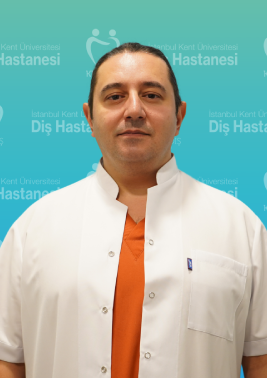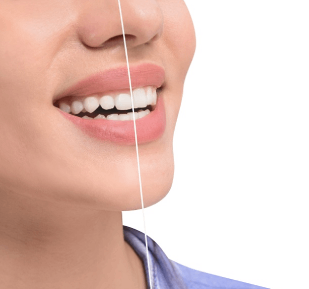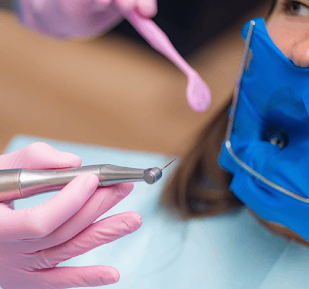
Periodontology
Periodontology is the specialty that deals with the treatment of the (gingiva) gums and the tissues surrounding and supporting the tooth.
Periodontal diseases are one of the most common chronic diseases observed in society. These diseases can affect one or more teeth and they can be observed in people of all ages.
Periodontal diseases are classified by various names according to their agents or clinical course. The main agent is mostly the microbial plaque that accumulates on the teeth, but there may be additional factors that affect the severity of the disease. It is highly beneficial to regularly monitor periodontal health of individuals, especially who have a history of tooth loss / periodontal diseases at an early age in their family, smoke, or have conditions that affect general health such as diabetes.
Healthy gums have a matte appearance, a light pink color and a hard consistency. In some patients, its surface may be rough, like an orange peel. It does not bleed with brushing.
What Are The Most Common Periodontal Diseases?
- Gingivitis
- Periodontitis
- Gingival abscess and periodontal abscess
- Gingival hyperplasia
- Gingival recession
What Are Periodontal Treatments?
There are two types of periodontal treatments: non-surgical and surgical.
Non-Surgical Periodontal Treatment
Ensuring Good Oral Hygiene
As with all treatments, patient compliance is highly important in periodontal treatments. A successful treatment result can only be achieved with the cooperation of a doctor and patient. In this case, the patient's duty is to keep up with a daily oral hygiene routine as recommended by his/her doctor. For the prevention of the disease and the healing of tissues, it is necessary to remove the microbial plaque that has accumulated on the tooth.
During the examination and treatment, the dentist explains to the patient the correct choice of hygiene products such as toothbrushes, toothpaste, dental floss, and effective oral hygiene methods adapted to the patient's current condition.
Dental Surface Cleaning
To control the infection and provide a suitable environment in which tissues can heal, the dentist removes the hardened dental plaque like dental calculus on the surface of the tooth. The root surface is rearranged for the gums to hold on to the tooth in a healthy way. These operations are performed with electrically operated vibrating tools and hand tools. Depending on the severity of the disease, the number of sessions and the frequency of check-ups may vary. If along with these procedures, negative factors that facilitate the accumulation of plaque, such as tooth decay, high filling and ill-fitting dental prostheses, are detected, the patient is referred for the treatment of these problems.
Surgical Periodontal Treatment
If conditions that cannot be completely treated with a non-surgical treatment are detected during check-ups, a surgical treatment option suitable for the patient's condition is recommended as the next stage. These surgical treatments are mostly performed under local anesthesia.
Flap Surgery
When inflammatory osteolysis is severe or irregular, periodontal pockets can not be reduced with non-surgical treatments, a section of the root surface can not be reached without non-surgical methods due to the structure of the tooth or root. Therefore, the gingiva is cut surgically, and the bone and root surface are directly intervened. Soft tissues that are affected by inflammation on the surface of the root and bone, which are difficult to heal, and calculus in hard-to-reach areas are cleaned. Irregular areas on the bone surface are corrected, and in suitable cases, bone cavities are completed with the help of products such as bone graft (bone powder) and membrane to ensure the regeneration (re-formation) of tissues that support the tooth.
Gingivectomy/Gingivoplasty
It is the operation of cutting and correcting the gingiva with various hand tools, rotary tools and laser to reduce the depth of periodontal pockets, to treat gingival hyperplasia, to reveal sufficient tooth height before operations such as prosthetics or to provide gum aesthetics.
Phrenectomy
In some patients, the muscles connecting the lips and cheeks to the jawbones are situated in an area closer to the teeth. In such cases, problems such as gingival recession and diastema occur. With the operation of phrenectomy, such problematic muscle connections are surgically restored to a harmless position.
The Processes Of Closing The Root Surface And Increasing The Attached Gingiva
When the height of attached gingiva is insufficient, the patient may not be able to maintain effective oral hygiene or the likelihood of gingival recession may increase. In the case of gingival recession, various surgical methods have been developed to increase the amount of gingiva that is immobile around the tooth, which supports the tooth better, and to close the root surface. During the examinations and check-ups, the current situation is examined with its causes and the most suitable method is determined with its alternatives. In these surgical interventions, sometimes the patient's own tissues can be transferred from one area (for example, the palate) to another area, other commercially available products may be preferred as well.















